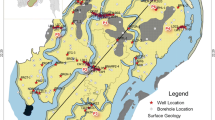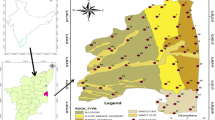Abstract
Hydrochemistry in parts of the Lower Tista Floodplain in northwest Bangladesh is dominated by alkalies and weakly acid, having highest concentration of sodium cations and bicarbonate anions respectively. Groundwater is characterized by sodium-calcium and sodium-potassium cation and bicarbonate-chloride-sulphate anion facies, and genetically ‘normal chloride’, ‘normal sulphate’, and ‘normal carbonated’ type, and soft to saline. Based on electrical conductivity values, the area is divided into northern fresh and southern saline groundwater zone, and values like salinity, Na%, SAR, and RSC and a good correlation between Na+ and Cl−, and Cl− and salinity reveals increasing salinity with depth indicating a mixing of fresh and saline bodies due to marine transgression (?) during Holocene period in the Bengal delta. The rock weathering is likely to affect the groundwater quality by dolomite dissolution and calcium precipitation, representing reverse softening process and is brine seawater. Water extracted from shallow zone (from 20 to 30 m) has suitability for drinking purpose, livestock consumption and irrigation purposes, and partially suitable for industrial use, but that from deeper zone (from 30 to 50 m) is generally poor and unsuitable especially for irrigation purposes with low alkali and moderate to high salinity hazard. So groundwater can be used for irrigation in the area of fine textured soil with proper management practices.
Similar content being viewed by others
References
Alam, D., Huq, S.M.I., Rahman, S and Anam, K. (1991) A Handbook on Chemical Analysis of Soil, Plant and Water. 1st ed., Ahmed Perveg Shamsuddin Publication, Dhaka.
American Public Health Association (APHA) (1995) Standard Methods for the Examination of Water and Wastewater, 16th ed. American Public Health Association, Washington.
Back, W. (1961) Technique for Mapping of Hydrochemical Facies. U.S. Geol. Survey Prof. Paper 424-D, pp.380–382.
Bangladesh Water Pollution Control Board (BWPCB) (1976) Bangladesh Drinking Water Quality Standard, BWPCB, 156p.
EPC and Mott Macdonald (1994) Study to forecast declining groundwater levels in Bangladesh, Report for UNICEF and DPHE, Engineering and Planning Consultants, Bangladesh.
Gibbs, R.J. (1970) Mechanism Controlling WorldWater Chemistry. Science, v.170, pp.1088–1090.
Hounslow, A.W. (1995) Water Quality Data Analysis and Interpretation. Lewis Publishers, New York, pp.45–128.
Institute of Water Modelling (IWM) (2006) Project Brief for Deep Tubewell Installation Project in Barind Area, Groundwater Model Study for Deep Tubewell Installation Project in Barind Area. Draft Final Report, IWM, Dhaka.
Jahan, C.S. (1997) Origin of groundwater and prospective of its utilization in Barind area, Bangladesh, Unpublished PhD thesis. Moscow State Geological Prospecting Academy, Russia.
Jahan, C.S., Mazumder, Q.H. and Asaduzzaman, M. (2004) Long Term Trend of Water Level in Barind Area of Bangladesh: A Statistical Analysis for Groundwater Potentiality Study. Bangladesh Jour. Geol., v.23, pp.55–69.
Karim, M.A. (1987) Upazilla-wise Groundwater Recharge Condition of Bangladesh. GWC-II, BWDB, Dhaka.
Khan, A.A., Akhter, S.H. and Alam, S.M.M. (2000) Evidence of Holocene transgression, dolomitization and the source of arsenic in Bengal delta. In: Mohamed and Al Hossain (Eds.),Geoengineering in Arid Lands, Balkema, Rotterdam.
Lloyd, J.W. and Heathcote, J.A. (1985) Natural Inorganic Hydrochemistry in Relation to Groundwater: An Introduction, Claredon Press, Oxford, 291p.
Piper, A.M. (1944) A graphic procedure in the geochemical interpretation of water analysis. Amer. Geophys. Union Trans., v.25, p.914–923.
Piper, A.M., Garrett, A.A., et al. (1953) Native and contaminated groundwater in the Long Beach-Santa Ana Area, California. U.S. Geol. Surv. Water-Supply Paper 1136, 320p.
Raghunath, H.M. (1987) Groundwater.Wiley Eastern Ltd., Delhi, India, 563p.
Schoeller, H. (1955) Utilite de la notion des exchange de bases pour la comparison des eaux souterraines: France Societe Geologie Comptes rendus Sommarie et Bulletin Serie 5, v.5, po.651–657.
U.S. Federalwater Pollution Control Administration, (1968) Report of the Committee on Water Quality Criteria. Washington D.C., 234p.
U.S. Public Health Service (USPHS) (1962) Drinking Water Standards, 1962: U.S. Public Health Service Publ. no.956, 61p.
U.S. Salinity Laboratory Staff (USSLS) (1954) Diagnosis and improvement of saline and alkali soils. U.S. Department of Agriculture Handbook 60, 160p.
Wilcox, L.V. (1967) Classification and Use of Irrigation Water, USDA Circ. 969, Washington D.C., USA, 19p.
Woobaidullah, A.S.M., Ahmed, K.M. and Hasan, M.A. (1996a) Electrical Resistivity and Hydrogeological Study for Saline Groundwater Investigation in Manda Thana, Naogaon District. Final Report, Bangladesh UGC Funded Research Project, 59p.
Woobaidullah, A.S.M., Rahman, M., Romer, A. and Arndt, R. (1996b) Geoelectrical resistivity survey for suitable freshwater aquifer identification in the coastal belt of southeast Bangladesh. Jour. Geol. B.A. Band., v.139/1. pp.127–137.
Woobaidullah, A.S.M., Ahmed, K.M. and Hasan, M.A. (1998) Saline Ground Water Management in Manda Thana of Naogaon District, NW Bangladesh. Jour. Geol. Soc. India. v.51, pp.49–56.
World Health Organization (WHO) (1971) International Standard for Drinking Water: Geneva, WHO, 70p.
World Health Organization (WHO) (1983) Guidelines to Drinking Water Quality, 1st ed, World Health Organization, Geneva, 186p.
Author information
Authors and Affiliations
Corresponding author
Rights and permissions
About this article
Cite this article
Afroza, R., Mazumder, Q.H., Jahan, C.S. et al. Hydrochemistry and origin of salinity in groundwater in parts of Lower Tista Floodplain, northwest Bangladesh. J Geol Soc India 74, 223–232 (2009). https://doi.org/10.1007/s12594-009-0124-7
Received:
Accepted:
Published:
Issue Date:
DOI: https://doi.org/10.1007/s12594-009-0124-7




